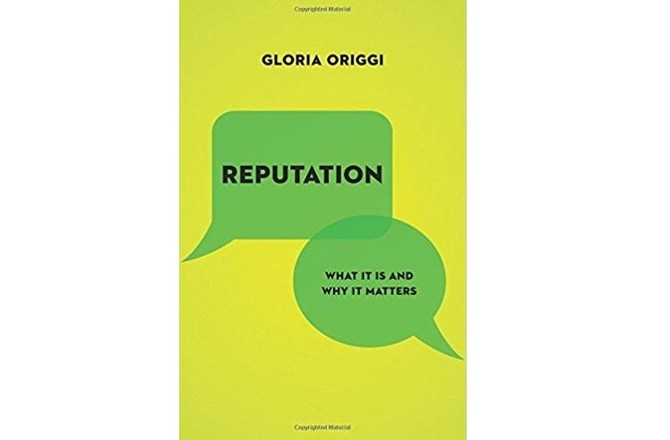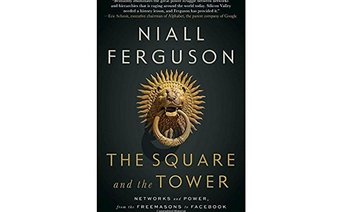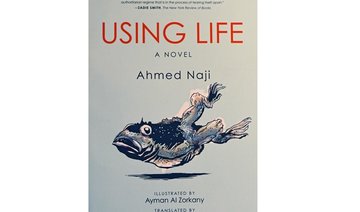With the advent of the Internet and social media, reputations have become vulnerable, fragile and elusive, but are also an indispensable and ubiquitous tool to determine how others see us and also to guide us in our choice of doctors, websites or brands.
Gloria Origgi, an Italian philosopher based in Paris, is a senior researcher at the Institute Jean Nicod at the National Center for Scientific Research. Her previous books include one on trust and another on the future of writing. In her latest publication, “Reputation,” Origgi tries to explain why reputation is so important personally and socially, how it gets distorted and how it influences what others say about us.
To start with it was a conference on reputation organized in Rome in 2007 which aroused Origgi’s interest in the subject. Then, four years later, in 2011, she gave a seminar at the School for Advanced Studies in the Social Sciences in Paris on the subject of reputation. During her stay at the Italian Academy for Advanced Studies at Columbia University in New York in 2013, Origgi wrote the first part of this book, which was originally published in French in 2015.
Although reputation is a subject that affects everyone, little has been written about it. However, the need for such a book is not the only reason why it was so rapidly translated in English and published. Origgi has written a compelling, original and thought-provoking book that sheds light on the complex process behind the formation of a reputation.
Origgi writes: “The book raises two fundamental philosophical questions about reputation. First, can reputation be considered a rational motivation for action? What drives us to defend, improve or repair our reputation? And second, can reputation be considered a rational justification in the acquisition of information?”
One of the reasons this book is so readable is due to the eclectic approach chosen by the author. Origgi’s multi-disciplinary method spans practically all the social sciences, including sociology, economics, anthropology, cognitive science and linguistics. She has also used a profusion of examples drawn from literature and real life.
To understand who we are and how we see ourselves being seen we need to know that all of us have two egos and two selves. One is our subjectivity, a central philosophical concept, which is related to consciousness, personhood, reality and truth. The other ego, or self, is our reputation. This social self exerts control to a surprising extent. It does not really belong to us, but it is the part of us that lives in others. It triggers strong feelings, such as shame, embarrassment, self-esteem, guilt and pride, which are deeply ingrained in our emotional experience.
According to the book, more than a third of the homicides committed in the US have minor causes and most crimes without serious motives are committed due to honor, pride and reputation. So why do we attach so much importance to the image that others have of us, a representation that exists only in their minds?
“This book,” writes Origgi, “explores the hidden logic of our double ego. Reputation itself is strikingly enigmatic. How a good name is gained or lost is often inexplicable. Why some reputations are considered good and others bad can be equally obscure.”
All famous people are conscious of their image and they are ready to pay image consultants exorbitant salaries to manipulate other people’s ideas. We all enjoy the feeling that we experience when we think that we have been appreciated for what we are truly worth. However, the relation between the image that we project of our self and our true self is highly complex.
“Reputation is a cloud of opinions that circulates according to its own laws, operating independently of the individual beliefs and intentions of those who hold and communicate the opinions in question,” explains Origgi.
Surprisingly little has been written on the communicative nature of reputation. And yet, there is a basic difference between a mere opinion and what we believe we should think of someone after we have heard the opinion of experts we respect. Most of our opinions are influenced by the opinions voiced by writers and thinkers that we respect. We often believe what we read in newspapers or magazines without checking whether that opinion is based on true facts because we trust the writer or it happens to be the only information available at the time.
The author gives an interesting example of a debate between Mitt Romney and Barak Obama during the 2012 US presidential campaign. She had not followed the debate but embraced her friends’ opinions who claimed that Obama had performed poorly. When she finally decided to watch the televised debate, she realized how unjust she had been. Obama was nowhere near as bad as she had described him. He was, on the contrary, “more skillful and precise than Romney.”
Origgi adds: “The question this raises is why it is so easy to internalize and echo the viewpoint of others, unthinkingly, even when important issues are at stake.”
Origgi also examines how the Internet and social media contribute to the creation of formal and informal reputations. Social life is the informational trace of who we are. All our interactions generate bits of socially shared information that accumulate gradually to define how we are seen…others will observe our actions as pieces of information that tell them something about us,” she writes.
Nowadays, we can build our social image through social media, personal webpages and Facebook profiles. All this social information about us follows us everywhere. The web empowers us with the possibility to control our identity. On the other hand, our image and our identity can be manipulated, even hijacked. “Our dynamically shape-shifting reputation” contributes to the development of human personality. “Without consciousness of the interdependence between me and my image in the eyes of others, between my actions and my reputation, I cannot understand either who I am or why I act,” concludes Origgi.
Thanks to the web, we play an active and participative role in the development of our human personality and the shaping of our reputation. It is an important takeaway in what has proven to be an eye-opening book.
Book Review: Understanding why reputations are so important
Book Review: Understanding why reputations are so important

What We Are Reading Today: ‘Chinese Espresso’ by Grazia Ting Deng

Italians regard espresso as a quintessentially Italian cultural product—so much so that Italy has applied to add Italian espresso to UNESCO’s official list of intangible heritages of humanity. In this book, Grazia Ting Deng explores the paradox of “Chinese Espresso”— the fact that this most distinctive Italian social and cultural tradition is being preserved by Chinese immigrants and their racially diverse clientele.
What We Are Reading Today: ‘Bartleby and Me’

Writers love to write about writing and none seemingly more so than Gay Talese, the journalist known as a pioneer of the American literary moment called “New Journalism.” This style of writing originated in the 1960s and ‘70s and combines journalistic research with creative non-fiction.
Talese started his career as an obituary writer at the New York Times and, later, as a magazine writer who ended up reluctantly penning the most widely read magazine articles of all time. He showcases some of that editorial wisdom — and reporting mishaps — in his 2023 book, “Bartley and Me: Reflections of an Old Scrivener.”
Now 92 years old, he writes vividly about his early reporting days and the stories behind the stories; he masterfully weaves in stray strands that somehow come together into a coherent narrative. Talese writes crisp copy. He writes about nobodies and somebodies with equal fervor.
He recalls his time as a young reporter on assignment where, at the insistence of his persistent editor, he attempted to sit down for an interview with the elusive and super-famous star Frank Sinatra. Talese recounts how he repeatedly tried — and failed — to pin down “Ol’ Blue Eyes” while chasing him around California in the 1960s. He eventually published his distinctively titled profile, “Frank Sinatra Has a Cold,” in the April 1966 issue of Esquire. That piece of writing is considered one of the most celebrated pieces of magazine journalism to date.
Talese’s tales are mostly centered around his time in New York. He recalls things in meticulous detail — for example, pointing out the exact address and precise building within a neighborhood to help the reader visualize the space. The city is always a leading part of the story.
“New York is a city of things unnoticed,” he wrote 60 years ago, something that could easily be written today. He recalls the early days of his journalistic career in New York, churning out newspaper copy and still, now, being ever-so-curious about everything. The pages of this book show that we all, alongside him, still have much more to notice.
The title of the book was inspired by American author Herman Melville’s short story, “Bartleby, the Scrivener: A Story of Wall Street,” published in the 1800s. This is a social criticism piece about a lawyer who hires a peculiar scrivener or clerk, Bartleby, and the adventures (or misadventures) that ensue.
In his version, Talese shares with us a fresh piece of original reporting titled “Dr. Bartha’s Brownstone,” which is his version of “Bartleby.” This time, however, Bartleby is an unknown doctor who makes his bombastic mark on the city one random summer day. It is a brilliant piece of journalism about journalism.
What We Are Reading Today: ‘The Proof Stage’ by Stephen Abbott

The discovery of alternate geometries, paradoxes of the infinite, incompleteness, and chaos theory revealed that, despite its reputation for certainty, mathematical truth is not immutable, perfect, or even perfectible.
Beginning in the last century, a handful of adventurous playwrights took inspiration from the fractures of modern mathematics to expand their own artistic boundaries.
What We Are Reading Today: ‘The Royal Inca Tunic’ by Andrew James Hamilton

The most celebrated Andean artwork in the world is a 500-year-old Inca tunic made famous through theories about the meanings of its intricate designs, including attempts to read them as a long-lost writing system.
But very little is really known about it. “The Royal Inca Tunic” reconstructs the history of this enigmatic object, presenting significant new findings about its manufacture and symbolism in Inca visual culture.
What We Are Reading Today: ‘The Evolution of Power’ by Geerat Vermeij

Power has many dimensions, from individual attributes such as strength and speed to the collective advantages of groups.
“The Evolution of Power” takes readers on a breathtaking journey across history and the natural world, revealing how the concept of power unifies a vast range of phenomena in the evolution of life—and how natural selection has placed humanity and the planet itself on a trajectory of ever-increasing power.

















